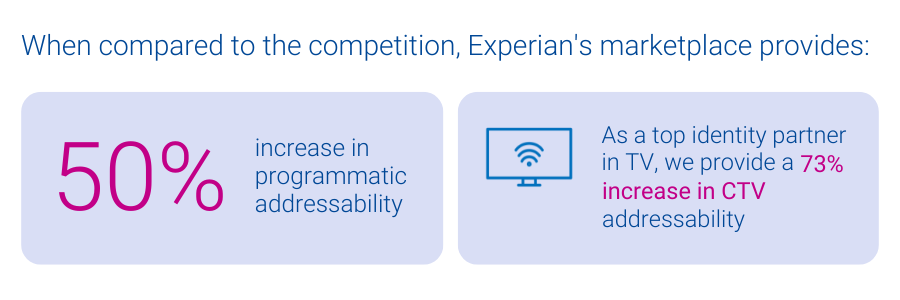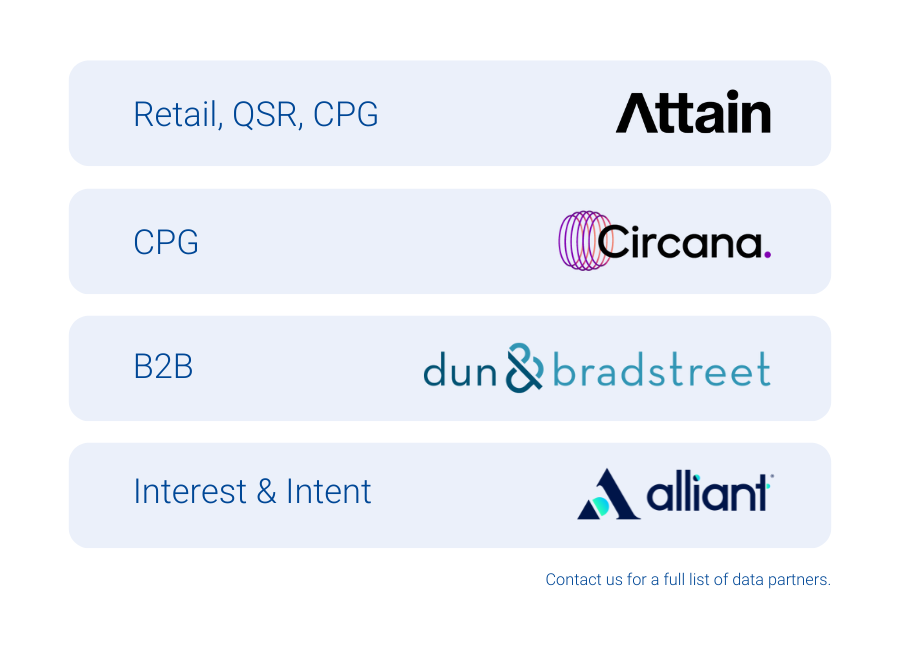
In a perfect world, we’d all have a single, go-to grocery store that carried everything on our shopping list – fresh produce, gourmet coffee beans, rare spices, and maybe even that special-grade olive oil, right alongside our wholesale bulk purchases at unbeatable prices. It would be convenient and efficient, and it’d save a lot of driving around town.
The changing data marketplace: From one-stop shop to specialized selection
For a long time, data buyers enjoyed something similar in their world: a small set of large-scale data marketplaces that offered a wide array of audiences, making it easy to load up on whatever you needed in one place. Not only are there fewer places to pick everything up, but new factors like privacy and signal deprecation are placing a spotlight on quality and addressability.
Just as our dinner plans are growing more ambitious insofar as we want health, flavor, value, and convenience all in one place – so are our data strategies. Instead of a single steak-and-potatoes meal, today’s data marketplace operators might be cooking up a complex menu of campaigns.
“Experian has been a longstanding partner of DISH Media, and we’re excited to be an early adopter of their marketplace which leverages the foundation of their identity solutions to ensure maximum cross-channel reach as we look to expand the breadth and depth of data we use for addressable TV.”
Kemal Bokhari, Head of Data, Measurement & Analytics, DISH Media
As a result, data buyers are beginning to shop around. Some still rely on large-scale marketplaces for familiar staples, but now they have reasons to explore other options. Some are turning to providers known for offering top-tier, transparently sourced segments. Others are focusing on specialty providers that excel in one area.
A more selective approach to data buying
In this environment, choosing where to “shop” for data is becoming more deliberate and selective. Data buyers aren’t just thinking about broad scale; they’re looking to prioritize quality, durability, data privacy, and differentiation. They need to place higher value on data marketplaces that can maintain audience addressability over time, despite signal loss. Sometimes, that means accepting a smaller assortment in exchange for tighter vetting and more reliable targeting. Other times it means mixing and matching – stopping by one marketplace for premium segments and another for cost-friendly, wide-reaching data sets. Either way, they can benefit from having more choices.
“Experian has been a longstanding partner of DISH Media, and we’re excited to be an early adopter of their marketplace which leverages the foundation of their identity solutions to ensure maximum cross-channel reach as we look to expand the breadth and depth of data we use for addressable TV.”
Kemal Bokhari, Head of Data, Measurement & Analytics, DISH Media
Experian’s marketplace: A trusted source for high-quality data
Experian’s vetted and curated blend of data partners and vertically-aligned audiences offers a trusted specialty store for data buyers. Experian’s marketplace, powered by identity graphs that include 126 million households, 250 million individuals, and 4 billion active digital IDs, enables partner audiences to be easily activated and maintain high addressability across display, mobile, and connected TV (CTV) channels. In particular, Experian’s marketplace provides:


The future of data marketplaces: Precision and flexibility matter
The evolution of data marketplaces reflects the industry’s shifting priorities. Data buyers seek specificity, reliability, and adaptability to align with their diverse campaign needs. The best data strategy, much like the best grocery run, isn’t about grabbing everything in one place – it’s about carefully selecting the right ingredients to create the perfect recipe for success. This shift underscores the importance of flexibility and precision as data buyers navigate a landscape shaped by privacy regulations, signal loss, and evolving consumer expectations.

As data marketplaces adapt to meet these demands, they are redefining what it means to deliver value. Experian’s marketplace enables buyers to strike the perfect balance between reach and quality by offering enhanced match rates, precise audience planning, and seamless distribution. In this new era, data buyers have the tools and options to craft campaigns that are impactful and aligned with the increasingly selective and privacy-conscious digital landscape. The key is recognizing that today’s data strategy is about utilizing the strengths of many to create a cohesive and effective whole.
If you’re interested in learning more about Experian’s marketplace or becoming an active buyer or seller in our marketplace, please contact us.
Latest posts

It is time for us to polish off our crystal ball and give our predictions straight from consumers’ fingertips for the hot products of the 2012 holiday season. Gadgets will reign across many ages Tablets including LeapPads, Tabeos, iPads, Kindles and others will continue to be a popular gift this year, with more choices than ever. On the list of top product-related search terms driving traffic to the Retail 500 category of sites, Kindle Fire HD and Windows 8 top the list as new products. Additionally, Meep!, a child friendly tablet appeared in the top fifteen. Accessories for both phones and tablets will also be popular, especially as the variety grows for iPhone 5 and iPad Mini. A reoccurring favorite gift for the holidays is UGGs which shows a decrease year over year. However, another brand with a similar product is Bearpaw, which is in the top ten searches and has seen big growth year over year. Source: Experian Hitwise Dolls, video games and Furbys, oh my! To identify the popular toys for gifts this year, we researched product-related search terms driving traffic to ToysRUs.com compared to last year’s holiday season. We uncovered trends in the doll category, Doc McStuffins as number one on the list, along with the classic Barbie, which saw a growth in searches year over year. The Furby is making a strong comeback at the number two spot with a reboot and new features. Another trend here is tablets, from branded searches like LeapPad and Kurio there is also the generic term ‘tablets for kids’. In the video game category, the new Wii U that is debuting just in time for Black Friday and should be a big gift this year, along with searches for PS3 games and the Nintendo 3ds xl are all in the top 20 searches. Source: Experian Hitwise Keywords of the consumer to identify demand Beyond product names, it is important to understand the actual way people search, using key phrases and questions. Last year, for example, there was a lot of activity around ‘in-stock’ products, such as the LeapPad explorer, which was hugely popular and quickly sold out in many stores. Retailers and marketers should monitor this throughout the season and make sure to optimize for in stock if there is a popular product that they have available. Source: Experian Hitwise Consumers also focus on what is the ‘best’ – so we see search activity around ‘best place to buy’, particularly around electronics. Questions such as ‘where to buy a’ specific product are also common, such as ‘where to buy a kindle’. These phrases offer opportunities to boost search campaigns by considering how consumers phrase their questions to ensure to capture these searches. Source: Experian Hitwise Quick tip: In the retail category there will tend to be a lot of retail branded store terms but to keep up with holiday search behavior and help make analysis quick, create portfolios of branded terms to easily exclude those from a certain category. When you strip out all the variations of that term you are able to gain insight into product searches that are most popular to a certain site or category. For more insight on the hot product trends for this year from our Hitwise trend-spotters, watch our webcast.

The holiday season – a most wonderful time of the year for retailers – is underway and marketers are tweaking their campaigns for better customer engagement and enchantment. There are many channels in which to reach top customers and prospective customers, and the new holiday season is a great time to refine strategies and tactics to ensure success. To help marketers in their quest, Experian Marketing Services recently conducted a market research study and learned that email marketing trumped all other tactics as the most successful initiative during the 2011 holiday season. Of the 84.2 percent who used email marketing, 95.8 percent reported that their campaigns were successful. Ninety-three percent said they planned to increase or maintain the same level of investment for the 2012 season. In addition to email, the study showed that paid search and online display advertising were the next most successful marketing tactics of the 2011 holiday season, with 48.9 percent naming search and 34.8 naming online display advertising as extremely or very successful campaign tactics. Our internal experts are currently looking at real-time data around these and other marketing channels and will present what they’ve learned during a live webinar on Thursday, October 25th at 1:00 p.m. EST. This information should prove very helpful to marketers who want to improve their campaigns based on current trends and results. Register for the holiday webinar and you’ll receive all of the survey data in the form of a 2012 holiday marketing white paper. Here’s to a joyous and profitable holiday season!

Experian Marketing Services pinpoints rising social network sites in new study – Instagram and Pinterest lead the pack According to a new study by Experian Marketing Services, niche social networks significantly increased their market share of all visits to social sites, with Instgram and Pinterest leading the pack. The following graph illustrates the global growth between July 2011 and July 2012, based on share of visits to all sites by country: Social site North America Australia Hong Kong New Zealand Singapore UK Instagram 17,319% 362% 132% 843% 8121% 2028% Pinterest 5124% 798% 2373% 643% 623% 1489% Other niche social networks that have experienced significant gain include Stock Twits in the US, Redidt in Australia, and FanPop in the UK. According to Bill Tancer, head of Global Research at Experian Marketing Services, the growth of Instagram and Pinterest over the past year has been successful because they haven’t tried to be ‘another Facebook.’ Both networks are image based – something people love and relate to better than just words. For retail brands, sites like Pinterest present a great opportunity to promote products in a compelling and organized way to a wide group of people, globally. Deeper functionally, combined with a lower technical barrier to entry, will result in new leaders in social media being created, accepted and used within a matter of days – compared to the rate of adoption happening now over the course of weeks and months. Also included in the study for July 2011 to July 2012: Country Social network Description Percentage increase of market share of visits to All Sites between July 2011 to July 2012 North America www.skillwho.com Social networking community which allow users to find people with skills from friends, friends of friends, local area or the community. 7435% increase http://stocktwits.com StockTwits is an open, community-powered investment idea and information service. 943% increase Australia www.reddit.com Site where users vote for what is popular or not. 177% increase Brazil Google+ Google+ integrates social services such as Google Profiles, and introduces new services identified as Circles, Hangouts and Sparks. 5750% increase New Zealand www.reddit.com Site where users vote for what is popular or not. 107% increase Singapore https://steamcommunity.com Community site that assists users in finding games to play, people to play against, and serves as a meeting place for friends and team mates. 124% UK Google+ Google+ integrates social services such as Google Profiles, and introduces new services identified as Circles, Hangouts and Sparks. 476% http://www.fanpop.com Network of fan clubs for fans of television, movies, music and more to discuss and share photos, videos, news and opinions with fellow fans. 178% What social networks do you use most frequently? Do the results of this study surprise you at all? Feel free to share your thoughts with our readers in the comments section below.